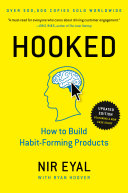

The Hook Model is the core framework of the book, consisting of four key components: Trigger, Action, Variable Reward, and Investment. These elements work together to create a cycle that encourages users to return to a product repeatedly. Triggers can be external, such as notifications or advertisements, or internal, stemming from users' emotions or routines. The Action is the behavior that the user takes in anticipation of a reward, such as scrolling through social media or checking an app. Variable Rewards are the unpredictable benefits that users receive, which can be social validation, material gain, or personal satisfaction. Finally, Investment refers to the effort or resources that users put into the product, which increases their likelihood of returning. The Hook Model emphasizes the importance of creating products that not only attract users but also keep them engaged over time.
Continue readingTriggers are essential in prompting user behavior. Nir Eyal categorizes triggers into two types: external and internal. External triggers are cues that come from the environment, such as notifications, emails, or advertisements. They serve as prompts that remind users to engage with a product. Internal triggers, however, are more powerful as they are tied to users' emotions and mental states. For example, a user may feel bored and instinctively open a social media app. To create a habit-forming product, it's crucial for designers to identify and cultivate internal triggers that resonate with users' feelings and routines. By understanding the psychological aspects behind triggers, product creators can design experiences that naturally draw users in.
Continue readingAction is the behavior that users take in response to a trigger. Eyal discusses the Fogg Behavior Model, which posits that behavior occurs when three elements converge: motivation, ability, and prompt. If a user is highly motivated to perform an action but lacks the ability, they will not engage. Conversely, if the ability is high but motivation is low, the action will also not occur. Therefore, product designers must ensure that their products are easy to use and that they lower barriers to entry. This can involve simplifying user interfaces, providing clear instructions, or using gamification to enhance motivation. The goal is to create a seamless experience that encourages users to take action consistently.
Continue readingVariable rewards are a critical component of the Hook Model that keeps users engaged. Unlike fixed rewards, which provide the same outcome every time, variable rewards introduce an element of unpredictability. This uncertainty creates excitement and anticipation, making users more likely to return. Eyal identifies three types of variable rewards: rewards of the tribe (social validation), rewards of the hunt (material gain), and rewards of the self (intrinsic satisfaction). By incorporating these types of rewards into a product, designers can enhance user experience and foster a deeper emotional connection. The unpredictability of these rewards taps into the brain's dopamine system, reinforcing the habit-forming behavior.
Continue readingInvestment is the final phase of the Hook Model, where users invest time, effort, or resources into a product. This investment not only improves the product for the user but also increases the likelihood of future engagement. The more users invest in a product, the more they feel a sense of ownership and commitment, making them more likely to return. This can manifest in various forms, such as creating content, building a profile, or contributing to a community. Eyal emphasizes that successful habit-forming products encourage users to invest in a way that enhances their experience and increases the product's value over time. This investment creates a cycle where users are drawn back into the product, sustaining the habit.
Continue readingWhile the Hook Model provides a framework for creating engaging products, Eyal stresses the importance of ethical considerations in product design. Habit-forming products can have a profound impact on users' lives, and designers have a responsibility to ensure that their products promote positive behaviors and well-being. This involves being mindful of how products can lead to addiction or negative consequences. Eyal encourages designers to consider the long-term effects of their products and to prioritize user welfare. By fostering a culture of ethical design, product creators can build trust with their users and contribute positively to society.
Continue readingThe final key idea revolves around the practical application of the Hook Model in various industries. Eyal provides case studies and examples from successful companies that have effectively implemented the Hook Model to create habit-forming products. He encourages readers to analyze their products through the lens of the Hook Model, identifying areas for improvement and opportunities for deeper user engagement. By applying the principles outlined in the book, product designers can create experiences that not only attract users but also foster lasting habits, ultimately leading to business success.
Continue reading